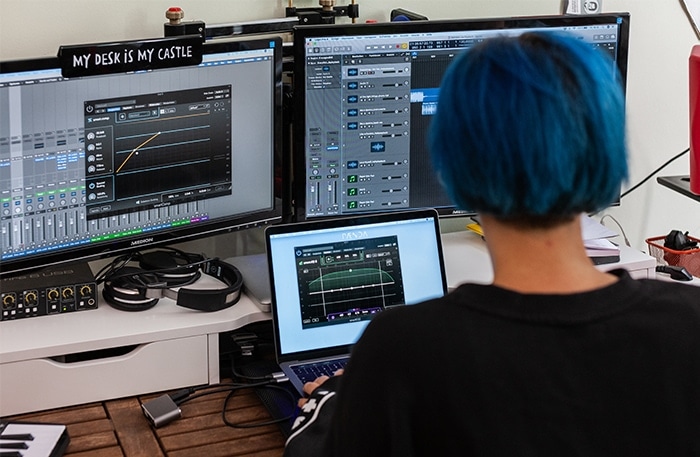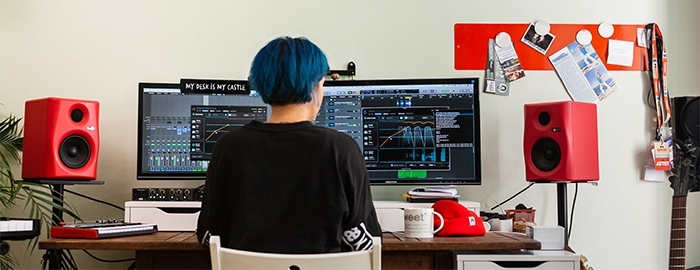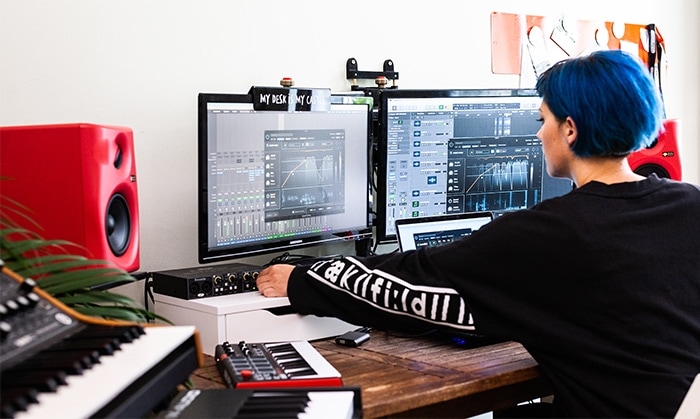When we met the Austrian artist Pænda for an interview at her apartment in Vienna, we immediately received a warm welcome. It’s easy to imagine how Pænda’s bubbly personality can electrify a big crowd when she performs her Electropop songs on stage. Pænda – Gabriela Horn – drew a lot of attention to herself and her music this year, when she was chosen to represent Austria at the Eurovision Song Contest – the biggest European music competition. But there is so much more that this artist already accomplished and one can learn a lot from her experiences and mindset.
Note: We replaced smart:comp with smart:comp 2! The spectro-dynamic compressor now sports sound-shaping option, an entire range of new profiles (single tracks, buses, mixes), a free-form transfer function with compression templates, states, mid/side processing, … and much more.
Pænda has already released two music albums, two singles and a promo CD of her song “Limits” that she competed with at the Eurovision Song Contest. But before Gabriela became Pænda, her art wasn’t as well received as it is now. “I can’t recollect a time, where I haven’t made music. I think I tried to be someone who I wasn’t for quite some time and somehow nobody wanted to hear what I did. When I became Pænda though, I remember sitting down and thinking I just want to do what I love – for my own amusement. Then, when my single ‘Waves’ came out in 2017, people started to notice me and my songs were played on the radio – that’s when I realized that things were different than before.”

Pænda‘s quaint home studio has a lot of character and there is a creative vibe running through the room where every instrument and device has its place. Being organized, not only regarding her surroundings but also in her approach to creating a song, is quite important for this artist. She does a lot on her own – from songwriting, composing and arranging to singing, playing instruments, recording and producing – hence, Pænda has had to find a strategy that keeps her on track. For her, it’s best to split up the different roles she needs to play when creating a song. “There is the time where I am the musician and I can come up with lots of ideas – it doesn’t matter if they are commercially viable. But time is limited for this part.” Then she becomes the producer where she picks out the strong parts of the song, whether it’s a melody, a synthesizer part or a beat, and gets rid of everything that is either unnecessary or unproductive.
“Next, I become the engineer, where I don’t really care if it’s creatively cool or the producer in me says it sounds good or not. It’s only that everything has to be correct in an engineering way.” Since Pænda takes the responsibility for the songs she gives to the mixing and mastering engineer very seriously, she refuses to pass songs on that are sloppy. “I know that a lot of producers don’t care about the way they give the project to the engineer but I care because I think that that is time the engineer could better spend getting the most out of what you have given him. Instead he has to spend his time getting rid of the things that you should have.” In the last phase of the process she puts on all of her hats to decide which song is going to be a part of the album and whether anything is lacking or needs adjustment.

And this approach works very well for the artist. Pænda’s second album “Evolution II” is a result of her need to be independent – not having to rely on a producer or other musicians in order to create. “This album was the first thing I really wanted to do on my own. I wanted to see how far I could go with only my know-how. I really surprised myself. It was a huge personal success that I was able to produce an album all on my own – except for the final mixing and mastering but even that turned out exactly the way I had in mind.”
For Pænda, being independent doesn’t mean that she doesn’t work with other people or that she doesn’t appreciates the help and means they can provide. “I have often had the discussion of whether one needs a music label or not in order to be successful. With all the access to markets we have today, a lot of artists say that you don’t need a label to make it. I think, especially since I am a pop artist, that it is important to either have money or contacts if you want to be competitive. For me, it is necessary to have a label that gives me access to important people.”
Having a home studio also allows Pænda her independence but it literally has a high price. “I am part of the pop music industry and the standards are very high and you really have to have access to high quality gear. So, if you decide to do it on your own, you have to invest. That’s what I did and still do. You have to consider this if you decide to make music in your own little studio.”
Investing in gear already starts with buying the basics like good speakers or headphones. Pænda does know a workaround that is generally sound advice: “If you don’t have access to gear that lets you hear really well what you are doing, you gotta know your stuff, so you need to learn how to read an equalizer or analyzer – then you don’t need high-end gear because you can see what you are doing.”

Knowing what you are doing is something that Pænda quickly realized is crucial, but software such as A.I. powered plug-ins that help you to achieve results with basically a touch of a button isn’t something that the artist is opposed to. “I do think it’s cool that this kind of technology gives people the opportunity to get into the whole process very fast and to be independent. Still, I have to say that if you rely on it too much and if you don’t try to learn and don’t know what you are doing, pretty soon you will be stuck at a certain point. Melodies, ideas and knowledge about how and if sounds fit together, doesn’t come from A.I. These tools help you to get rid of those nerve-wracking moments that are unnecessarily taking up time. To people who think they can use tools like this and be superstars: That’s not how it works – sorry.”

When we did the interview, Pænda was working on a DJ-set for an electronic music festival she was going to perform at the next day. The project involved a few challenges and due to the lack of time, they needed to be coped with quite quickly. “The thing with this DJ-set of my own stuff is that I am dealing with very different audio material. Five songs are coming from one engineer, five from another and two songs are from my original productions. The whole thing wasn’t really balanced and the different degrees of loudness were a problem. In this case, I used smart:comp on the master and let it learn from the dense signal of a remix part. It saved me a lot of time and therefore kind of saved my ass.”

Pænda also is impressed by smart:comp’s sidechain mode with its frequency-dependent ducking. She told us that she loves to use pads but since she has a lot of mid-heights in her voice, layering can be very difficult. “Most of the pads only sound good when they are in a specific frequency range and they are often exactly where my voice is. This has always been a big issue in my recent productions and I have had to either come up with different ideas or really be careful that the pad isn’t in the way of my voice. What smart:comp does is that it only ducks the frequencies where my voice is.” Pænda lets us hear an example and her joy is infectious when she tells us: “Although the voice sample is not clear itself, you can totally hear the difference and it is much clearer than before.”